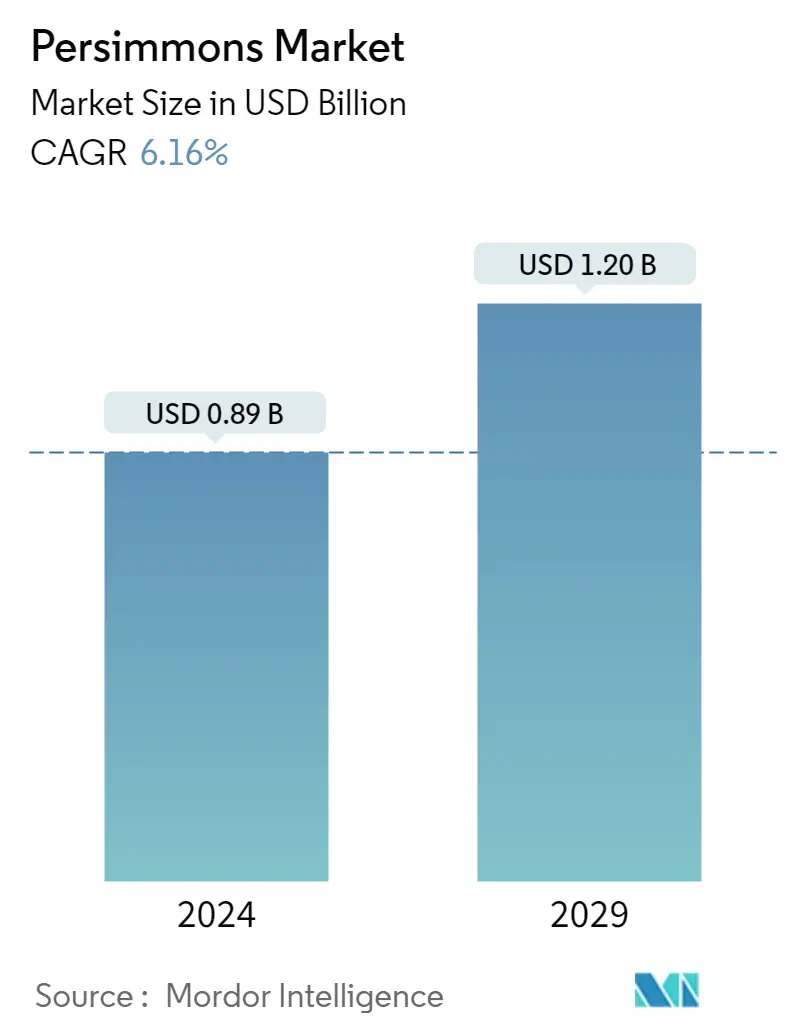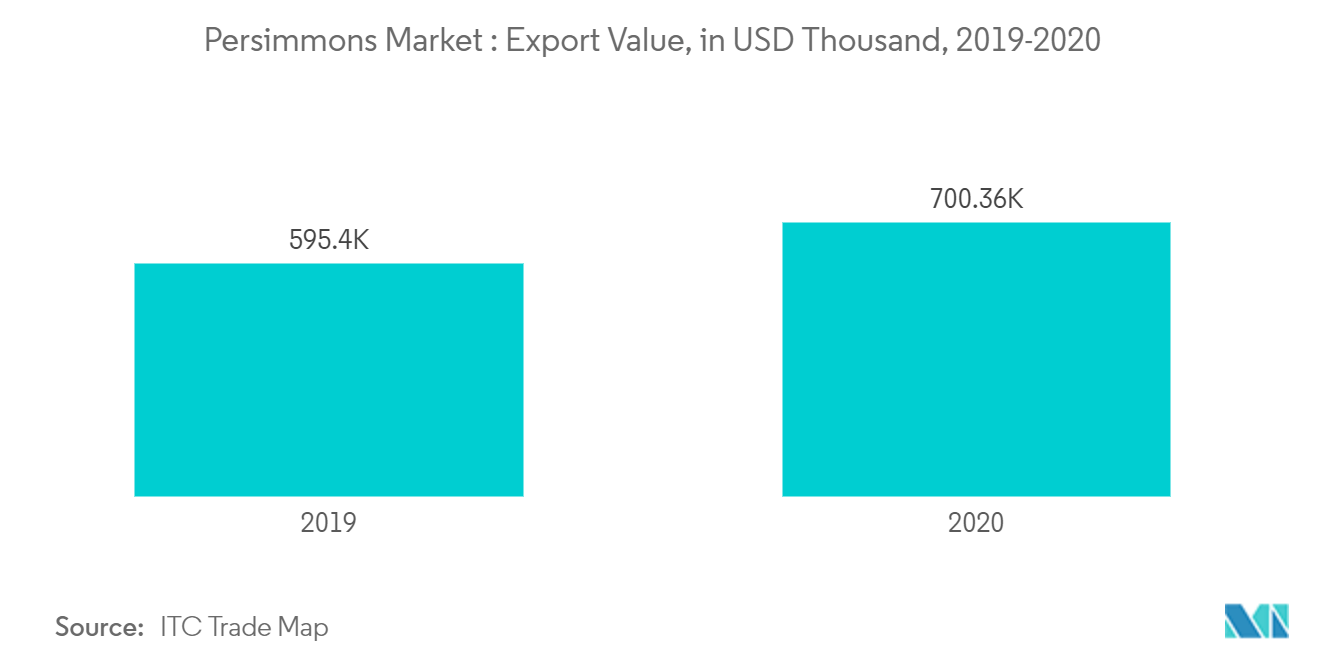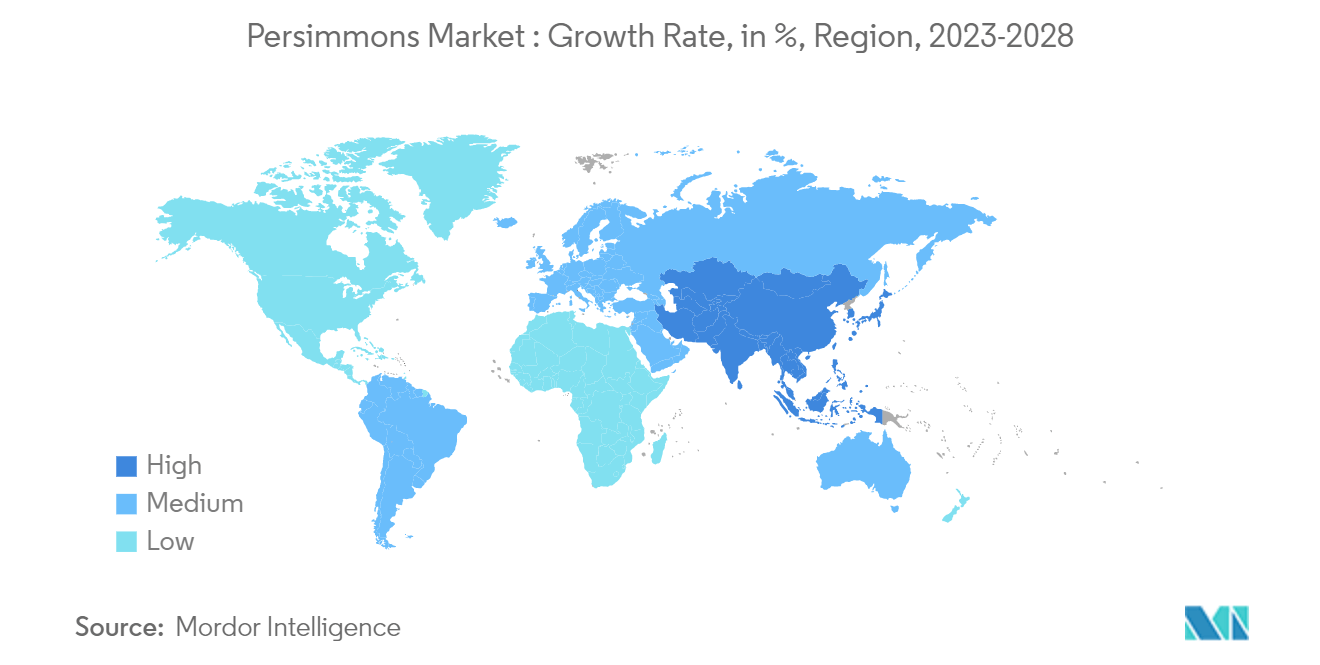Persimmon Market Size

| Study Period | 2019 - 2029 |
| Market Size (2024) | USD 0.89 Billion |
| Market Size (2029) | USD 1.20 Billion |
| CAGR (2024 - 2029) | 6.16 % |
| Fastest Growing Market | Europe |
| Largest Market | Asia |
Major Players*Disclaimer: Major Players sorted in no particular order |
Persimmon Market Analysis
The Persimmons Market size is estimated at USD 0.89 billion in 2024, and is expected to reach USD 1.20 billion by 2029, growing at a CAGR of 6.16% during the forecast period (2024-2029).
- The rise in demand due to the nutritive value of persimmons fruits and their high export value are the prime drivers of the market. Persimmons contain Vitamins A, C, K, and antioxidant properties that help increase insulin responsiveness and reduce oxidative stress. Persimmons can be used to make a variety of items, including baked foods (cookies, cakes, etc.), custards, ice creams, preserves, puddings, and pulp.
- Persimmon leaves are used to make herbal teas as well. This fruit helps in weight loss and increases immunity. Dried persimmons are another processing technique that can add value to the crop. Therefore, the utilization of dried persimmons in various applications provides lucrative growth opportunities to the market.
- According to the Food and Agriculture Organization (FAO), China, South Korea, Azerbaijan, Japan, and Brazil are the major producer of persimmon across the globe contributing 3,429.4 thousand metric tons, followed by 200.6 thousand metric tons, 192.4 thousand metric tons, 187.9 thousand metric tons, and 170.2 thousand metric tons, respectively, during the year 2021.
- China is the leading persimmons-producing country with more than half of the world's production share. The Japanese variety is the most commonly harvested persimmon in China. The second leading persimmon producer in the world is South Korea. The agricultural industry in these countries is actively trying to improve persimmon production as part of a strategy to significantly increase persimmon exports.
Persimmon Market Trends
High Export Value Drives the Market
- The export value of persimmons fruits was valued at USD 620.1 million in 2021, an increase of 12.7% from 2018. The potential use of persimmon surpluses and by-products in the development of new food products due to its high nutritional and bioactive compound content with bio-physiological functions such as antioxidant and antidiabetic properties is one of the major factors driving the export market.
- Spain, Azerbaijan, and Uzbekistan are the leading exporters of persimmons fruit. The main reason for such exports is the high prices of persimmons in the importing countries and production in a few countries. The demand for persimmons fruits is high in many countries with no or less production, such as Germany, the United States, etc. These countries import from countries like China, where the output is very high. Surprisingly, China's leading exporter is also one of the leading importers.
- According to the Georgian Ministry of Finance, the country exported 5,800 tons of persimmons worth USD 3 million. The main export destinations of Georgian persimmons are Russia, Ukraine, and Armenia - they accounted for 97% of exported persimmons in October 2021. At the same time, there is a significant difference in prices in export markets. The price of persimmons on the Russian market is 41% higher than the average export price of Georgian persimmons, which is USD 510 per ton.

Asia-Pacific Dominates the Market
- Asia-Pacific is the leading producer of persimmon fruit. China and Japan are the leading producers, with a production quantity of 3.4 million metric tons and 0.18 million metric tons, respectively, in 2021, almost 75% of the world's production. Europe stands second with 11.5% of the market share after Asia. The dynamic developments in the production and supply of horticultural products and sustainable growth in the production of persimmon are estimated to show a positive trend in the future.
- Chinese origin of the persimmon, favorable climate, and availability of many cultivars are the main reasons for their production in these countries. Chinese persimmon production keeps increasing while total acreage is maintained stable, and dried persimmon becomes the main product type for exporting.
- The improvement of breeding techniques fastened the achievement of new Chinese PCNA cultivars. Innovative trade models of persimmon products through Internet marketing, fruit quality evaluation, and post-harvest treatments for keeping the fruit fresh are some factors driving the persimmon market in China.

Persimmon Market News
- January 2023: The European Commission's new Common Agricultural Policy launched an initiative to support European farmers in their transition to a more sustainable and resilient agricultural industry, as well as in preserving the diversity of rural communities. These strategic plans support rural persimmons growers in improving production.
- February 2022: The Chinese government proposed a strategy to boost agricultural and rural development. The government is expected to achieve significant progress in rural agriculture development with technological support for modern agriculture for persimmons.
Persimmon Market Report - Table of Contents
1. INTRODUCTION
- 1.1 Study Assumptions and Market Definition
- 1.2 Scope of the Study
2. RESEARCH METHODOLOGY
3. EXECUTIVE SUMMARY
4. MARKET DYNAMICS
- 4.1 Market Overview
- 4.2 Market Drivers
- 4.3 Market Restraints
- 4.4 Value Chain Analysis
5. MARKET SEGMENTATION
-
5.1 Geography
- 5.1.1 North America
- 5.1.1.1 United States
- 5.1.1.1.1 Production Analysis
- 5.1.1.1.2 Consumption Analysis and Market Value
- 5.1.1.1.3 Import Market Analysis (Volume and Value)
- 5.1.1.1.4 Export Market Analysis (Volume and Value)
- 5.1.1.1.5 Price Trend Analysis
- 5.1.1.2 Canada
- 5.1.1.2.1 Production Analysis
- 5.1.1.2.2 Consumption Analysis and Market Value
- 5.1.1.2.3 Import Market Analysis (Volume and Value)
- 5.1.1.2.4 Export Market Analysis (Volume and Value)
- 5.1.1.2.5 Price Trend Analysis
- 5.1.1.3 Mexico
- 5.1.1.3.1 Production Analysis
- 5.1.1.3.2 Consumption Analysis and Market Value
- 5.1.1.3.3 Import Market Analysis (Volume and Value)
- 5.1.1.3.4 Export Market Analysis (Volume and Value)
- 5.1.1.3.5 Price Trend Analysis
- 5.1.2 Europe
- 5.1.2.1 Spain
- 5.1.2.1.1 Production Analysis
- 5.1.2.1.2 Consumption Analysis and Market Value
- 5.1.2.1.3 Import Market Analysis (Volume and Value)
- 5.1.2.1.4 Export Market Analysis (Volume and Value)
- 5.1.2.1.5 Price Trend Analysis
- 5.1.2.2 Italy
- 5.1.2.2.1 Production Analysis
- 5.1.2.2.2 Consumption Analysis and Market Value
- 5.1.2.2.3 Import Market Analysis (Volume and Value)
- 5.1.2.2.4 Export Market Analysis (Volume and Value)
- 5.1.2.2.5 Price Trend Analysis
- 5.1.3 Asia-Pacific
- 5.1.3.1 China
- 5.1.3.1.1 Production Analysis
- 5.1.3.1.2 Consumption Analysis and Market Value
- 5.1.3.1.3 Import Market Analysis (Volume and Value)
- 5.1.3.1.4 Export Market Analysis (Volume and Value)
- 5.1.3.1.5 Price Trend Analysis
- 5.1.3.2 Japan
- 5.1.3.2.1 Production Analysis
- 5.1.3.2.2 Consumption Analysis and Market Value
- 5.1.3.2.3 Import Market Analysis (Volume and Value)
- 5.1.3.2.4 Export Market Analysis (Volume and Value)
- 5.1.3.2.5 Price Trend Analysis
- 5.1.3.3 South Korea
- 5.1.3.3.1 Production Analysis
- 5.1.3.3.2 Consumption Analysis and Market Value
- 5.1.3.3.3 Import Market Analysis (Volume and Value)
- 5.1.3.3.4 Export Market Analysis (Volume and Value)
- 5.1.3.3.5 Price Trend Analysis
- 5.1.4 South America
- 5.1.4.1 Brazil
- 5.1.4.1.1 Production Analysis
- 5.1.4.1.2 Consumption Analysis and Market Value
- 5.1.4.1.3 Import Market Analysis (Volume and Value)
- 5.1.4.1.4 Export Market Analysis (Volume and Value)
- 5.1.4.1.5 Price Trend Analysis
- 5.1.4.2 Chile
- 5.1.4.2.1 Production Analysis
- 5.1.4.2.2 Consumption Analysis and Market Value
- 5.1.4.2.3 Import Market Analysis (Volume and Value)
- 5.1.4.2.4 Export Market Analysis (Volume and Value)
- 5.1.4.2.5 Price Trend Analysis
- 5.1.5 Middle-East and Africa
- 5.1.5.1 Israel
- 5.1.5.1.1 Production Analysis
- 5.1.5.1.2 Consumption Analysis and Market Value
- 5.1.5.1.3 Import Market Analysis (Volume and Value)
- 5.1.5.1.4 Export Market Analysis (Volume and Value)
- 5.1.5.1.5 Price Trend Analysis
- 5.1.5.2 Iran
- 5.1.5.2.1 Production Analysis
- 5.1.5.2.2 Consumption Analysis and Market Value
- 5.1.5.2.3 Import Market Analysis (Volume and Value)
- 5.1.5.2.4 Export Market Analysis (Volume and Value)
- 5.1.5.2.5 Price Trend Analysis
6. MARKET OPPORTUNITIES AND FUTURE TRENDS
** Subject To AvailablityPersimmon Industry Segmentation
Persimmon is an edible fruit (a berry, specifically) that grows on a variety of trees in the genus Diospyros. Persimmons can be eaten fresh, dried, or cooked and are commonly used around the world in jellies, drinks, pies, curries, and puddings.
The persimmons market is segmented based on geography into North America, Europe, Asia-Pacific, South America, and Middle-East and Africa. The report offers an analysis of production (volume), consumption (value and volume), import (value and volume), export (value and volume), and price trend analysis.
The report offers market size and forecasts in terms of value (USD thousand) and volume (metric ton) for all the above segments.
| Geography | North America | United States | Production Analysis |
| Consumption Analysis and Market Value | |||
| Import Market Analysis (Volume and Value) | |||
| Export Market Analysis (Volume and Value) | |||
| Price Trend Analysis | |||
| Geography | North America | Canada | Production Analysis |
| Consumption Analysis and Market Value | |||
| Import Market Analysis (Volume and Value) | |||
| Export Market Analysis (Volume and Value) | |||
| Price Trend Analysis | |||
| Geography | North America | Mexico | Production Analysis |
| Consumption Analysis and Market Value | |||
| Import Market Analysis (Volume and Value) | |||
| Export Market Analysis (Volume and Value) | |||
| Price Trend Analysis | |||
| Geography | Europe | Spain | Production Analysis |
| Consumption Analysis and Market Value | |||
| Import Market Analysis (Volume and Value) | |||
| Export Market Analysis (Volume and Value) | |||
| Price Trend Analysis | |||
| Geography | Europe | Italy | Production Analysis |
| Consumption Analysis and Market Value | |||
| Import Market Analysis (Volume and Value) | |||
| Export Market Analysis (Volume and Value) | |||
| Price Trend Analysis | |||
| Geography | Asia-Pacific | China | Production Analysis |
| Consumption Analysis and Market Value | |||
| Import Market Analysis (Volume and Value) | |||
| Export Market Analysis (Volume and Value) | |||
| Price Trend Analysis | |||
| Geography | Asia-Pacific | Japan | Production Analysis |
| Consumption Analysis and Market Value | |||
| Import Market Analysis (Volume and Value) | |||
| Export Market Analysis (Volume and Value) | |||
| Price Trend Analysis | |||
| Geography | Asia-Pacific | South Korea | Production Analysis |
| Consumption Analysis and Market Value | |||
| Import Market Analysis (Volume and Value) | |||
| Export Market Analysis (Volume and Value) | |||
| Price Trend Analysis | |||
| Geography | South America | Brazil | Production Analysis |
| Consumption Analysis and Market Value | |||
| Import Market Analysis (Volume and Value) | |||
| Export Market Analysis (Volume and Value) | |||
| Price Trend Analysis | |||
| Geography | South America | Chile | Production Analysis |
| Consumption Analysis and Market Value | |||
| Import Market Analysis (Volume and Value) | |||
| Export Market Analysis (Volume and Value) | |||
| Price Trend Analysis | |||
| Geography | Middle-East and Africa | Israel | Production Analysis |
| Consumption Analysis and Market Value | |||
| Import Market Analysis (Volume and Value) | |||
| Export Market Analysis (Volume and Value) | |||
| Price Trend Analysis | |||
| Geography | Middle-East and Africa | Iran | Production Analysis |
| Consumption Analysis and Market Value | |||
| Import Market Analysis (Volume and Value) | |||
| Export Market Analysis (Volume and Value) | |||
| Price Trend Analysis |
Persimmon Market Research FAQs
How big is the Persimmons Market?
The Persimmons Market size is expected to reach USD 0.89 billion in 2024 and grow at a CAGR of 6.16% to reach USD 1.20 billion by 2029.
What is the current Persimmons Market size?
In 2024, the Persimmons Market size is expected to reach USD 0.89 billion.
Which is the fastest growing region in Persimmons Market?
Europe is estimated to grow at the highest CAGR over the forecast period (2024-2029).
Which region has the biggest share in Persimmons Market?
In 2024, the Asia accounts for the largest market share in Persimmons Market.
What years does this Persimmons Market cover, and what was the market size in 2023?
In 2023, the Persimmons Market size was estimated at USD 0.84 billion. The report covers the Persimmons Market historical market size for years: 2019, 2020, 2021, 2022 and 2023. The report also forecasts the Persimmons Market size for years: 2024, 2025, 2026, 2027, 2028 and 2029.
Persimmons Industry Report
Statistics for the 2024 Persimmons market share, size and revenue growth rate, created by Mordor Intelligence™ Industry Reports. Persimmons analysis includes a market forecast outlook to 2029 and historical overview. Get a sample of this industry analysis as a free report PDF download.



